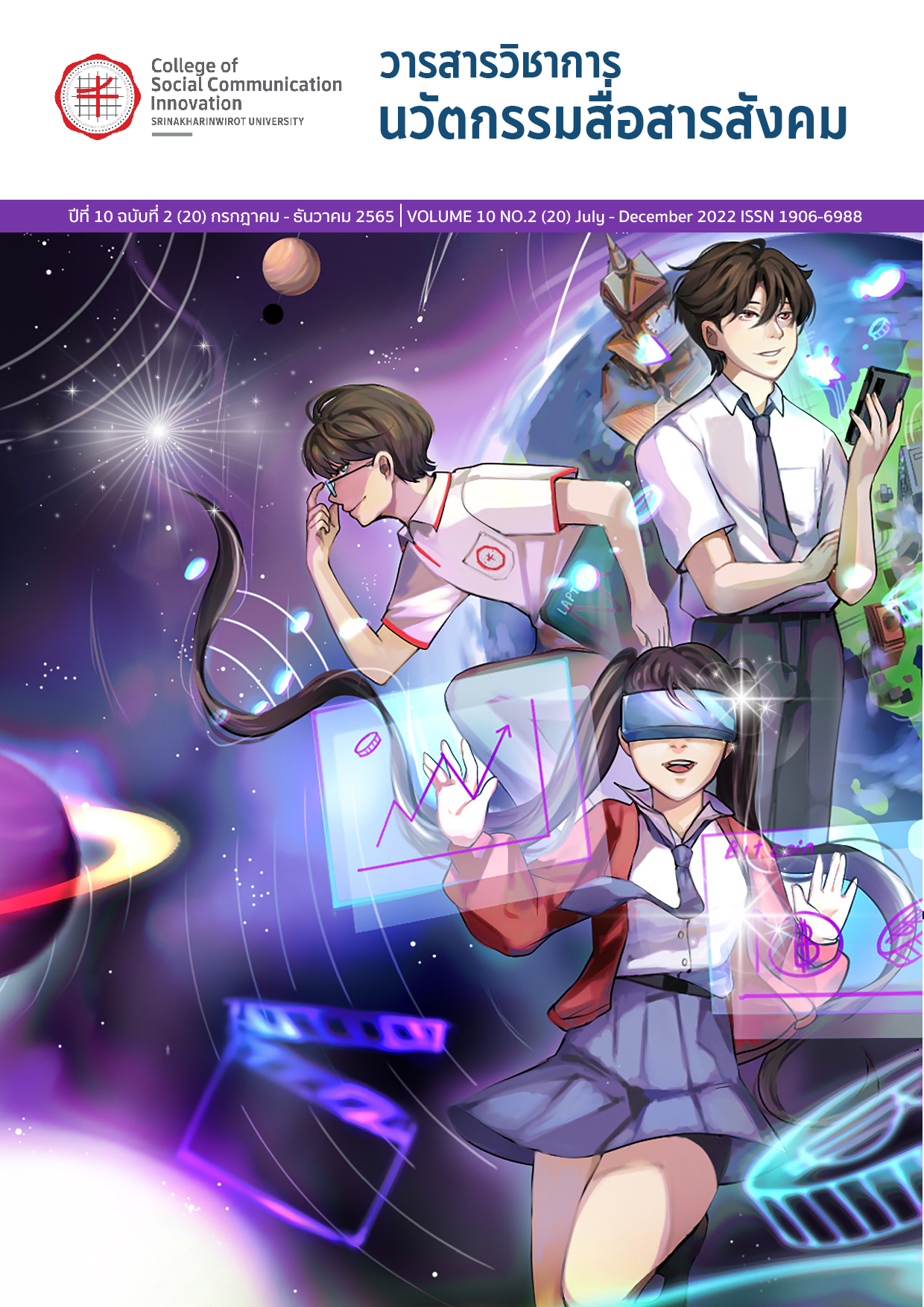การพัฒนานวัตกรรมสื่อเพื่อลดคำรุนแรงในข่าวและสร้างการรู้เท่าทันอารมณ์ในข่าว
คำสำคัญ:
นวัตกรรมสื่อ, อารมณ์ในข่าว , สื่อสังคม, การลดความรุนแรงในข่าว, การรู้เท่าทันข่าวบทคัดย่อ
งานวิจัยการพัฒนานวัตกรรมสื่อเพื่อลดคำรุนแรงในข่าวและสร้างการรู้เท่าทันอารมณ์ในข่าว ใช้กระบวนการวิจัยเชิงคุณภาพโดยมีจุดประสงค์ เพื่อพัฒนาต้นแบบเครื่องมือในการประเมินอารมณ์ในข่าว ชุดสื่อเพื่อการเรียนรู้ให้รู้เท่าทันอารมณ์ในข่าวและการแสดงออกบนสื่อสังคมออนไลน์ และนวัตกรรมกระบวนการในการสร้างการรู้เท่าทันอารมณ์ในข่าวและลดความรุนแรงในการสื่อสาร โดยดำเนินการวิจัยเชิงปฏิบัติการแบบมีส่วนร่วมกับกลุ่มตัวอย่างเป้าหมาย 3 กลุ่มคือ นักศึกษาระดับปริญญาตรีที่ศึกษาด้านนิเทศศาสตร์ ในจังหวัดนนทบุรีเป็นกลุ่มผู้สร้างเครื่องมือประเมินอารมณ์ในข่าวและชุดการเรียนรู้ นักเรียนชั้นมัธยมศึกษาตอนต้น จังหวัดกรุงเทพมหานคร กลุ่มที่ 1 เรียนรู้การรู้เท่าทันอารมณ์ผ่านชุดสื่อการเรียนรู้ และ กลุ่มที่ 2 เรียนรู้ผ่านกระบวนการเป็นผู้ผลิตสื่อ จากผลการศึกษาพบว่า เครื่องมือประเมินอารมณ์ในข่าว ใช้เป็นเครื่องมือในการสร้างการรับรู้และรู้เท่าทันต่ออารมณ์ที่มากับข่าวและอารมณ์ของผู้อ่านได้ ส่วนชุดสื่อลดความรุนแรงในการสื่อสารทำให้เกิดการตระหนักรู้ถึงปัญหา แต่กลุ่มเป้าหมายไม่ได้แสดงแนวโน้มที่ชัดเจนต่อการเปลี่ยนพฤติกรรมลดการสื่อสารที่อาจมีความรุนแรง แต่เมื่อใช้เครื่องมือควบคู่กับการให้กลุ่มตัวอย่างสวมบทบาทเป็นผู้ทดลองผลิตข่าวและเนื้อหาที่ลดความรุนแรงและอารมณ์ในข่าว พบว่า ทำให้กลุ่มตัวอย่างเป้าหมายที่มีส่วนร่วมในการวิจัยพัฒนา เข้าใจการประกอบสร้าง ผลของอารมณ์ในข่าวต่อพฤติกรรมผู้อ่าน และมีแนวโน้มพฤติกรรมที่จะหยุดคิด และไม่แสดงออกต่อประเด็นเรื่องราวนั้นด้วยอารมณ์รุนแรง รวมทั้งมีการเรียนรู้และเลือกใช้รูปแบบการนำเสนอข่าวและการแสดงออกบนสื่อออนไลน์อย่างมีเหตุผลและลดความรุนแรงลงได้ ดังนั้น การใช้กระบวนการผลิตสื่อในการสร้างการเรียนรู้ ทำให้เกิดการเข้าใจ การคิดรู้สึกตาม การปรับทัศคติ และ เห็นการลงมือทำจริงผ่านทั้งการทำสื่อและการปฏิบัติในชีวิตจริง ทำให้มีแนวโน้มของการปรับเปลี่ยนพฤติกรรม เป็นการพัฒนานวัตกรรมเพื่อใช้ประโยชน์ในการพัฒนาทักษะการรู้เท่าทันข่าวสารได้
เอกสารอ้างอิง
สกุลศรี ศรีสารคาม. (2564). เส้นทางพัฒนานวัตกรรมสื่อสร้างสรรค์ ออกแบบได้ด้วยโจทย์ให้สื่อเป็นฟันเฟืองทางสังคม [E-book]. คณะอนุกรรมการส่งเสริมสนับสนุนการสร้างนวัตกรรมเพื่อการพัฒนาสื่อปลอดภัยและสร้างสรรค์. https://www.thaimediafund.or.th/mediainnovatione/#p=1
สถาบันสุขภาพจิตเด็กและวัยรุ่นราชนครินทร์ กรมสุขภาพจิต. (2561). คู่มือปฏิบัติสำหรับการดำเนินการป้องกันและจัดการการรังแกกันในโรงเรียน [E-book]. บริษัท บียอนด์พับลิสชิ่ง จำกัด. จาก https://new.camri.go.th/_admin/file-content-downlaod/FM-514-1560738808.pdf
สถาบันสื่อเด็กและเยาวชน. (2561). เมื่อวาจาทำร้ายใจกัน..การเดินทางจาก "Hate Speech" สู่ "Cyberbullying" เอกสารการสื่อสารที่สร้างความเกลียดชัง (Hate Speech) และ การศึกษาการรังแกกันบนโลกไซเบอร์ของวัยรุ่น. สืบค้นเมื่อ 3 สิงหาคม 2565, จาก https://www.healthymediahub.com/media/detail/เมื่อวาจาทำร้ายใจกัน-การเดินทางจาก-Hate-Speech-สู่-Cyberbullying.
ดุสิตโพลเผยสังคมห่วงวัยรุ่นใช้ความรุนแรง แนะผู้ปกครองอบรมสั่งสอน. (2560). Posttoday. สืบค้นเมื่อ28 กุมภาพันธ์ 2564, จาก https://www.posttoday.com/politics/480546
Alper, M., & Herr-Stephenson, R. (2013). Transmedia Play: Literacy Across Media. Journal of Media Literacy Education, 5, 366–369. https://doi.org/10.23860/jmle-5-2-2
Baum, J., & Abdel Rahman, R. (2020, December 4). Emotional news affects social judgments independent of perceived media credibility. Social Cognitive and Affective Neuroscience, 16(3), 280–291. https://doi.org/10.1093/scan/nsaa164
Beckett, C. (2015, September 10). How journalism is turning emotional and what that might mean for news. The London School of Economics and Political Science. Retrieved September 21, 2022, from https://blogs.lse.ac.uk/polis/2015/09/10/how-journalism-is-turning-emotional-and-what-that-might-mean-for-news/
Currie Sivek, S. (2018). Both Facts and Feelings: Emotion and News Literacy. Journal of Media Literacy Education, 10(2), 123-138. https://doi.org/10.23860/JMLE-2018-10-2-7
Dehaene, S. (2014). Consciousness and the brain: Deciphering how the brain codes our thoughts. New York: Penguin.
Dogruel, L. (2013). Opening the Black Box: The Conceptualising of Media Innovation. In Media Innovations A Multidisciplinary Study of Change. Nordicom University of Gothenburg Box 713 SE 405 30. http://norden.diva-portal.org/smash/record.jsf?pid=diva2%3A1534759&dswid=7620
Dogruel, L. (2014). What is so special about media innovations? A characterization of the field. The journal of media innovations, 1(1), 52-69.
Herndon, F. (2008). Testing mindfulness with perceptual and cognitive factors: External vs. internal encoding, and the cognitive failures questionnaire. Personality and Individual Differences, 44(1), 32-41. https://doi.org/10.1016/j.paid.2007.07.002
Hobbs, Renee. (2010). Digital and Media Literacy: APlan of Action. Washington, DC: The Aspen Institute.
Hobbs, R. (2016). When teens create the news: examining the impact of PBS/news hour student reporting labs. Journalism Education, 5(1), 57–71. https://mediaeducationlab.com/sites/default/files/Hobbs%20-%20When%20teens%20create.pdf
Hoog, N., & Verboon, P. (2020, May). Is the news making us unhappy? The influence of daily news exposure on emotional states. British Journal of Psychology, 111(2), 157–173. https://doi.org/10.1111/bjop.12389
Jones, K., Libert, K., & Tynski, K. (2017, October 5). The Emotional Combinations That Make Stories Go Viral. Harvard Business Review. Retrieved July 5, 2021, from https://hbr.org/2016/05/research-the-link-between-feeling-in-control-and-viral-content
Klurfeld, J., & Schneider, H. (2014). News literacy: Teaching the internet generation to make reliable information choices. Washington, DC: Center for Effective Public Management at Brookings. Retrieved July 6, 2021, from https://www.brookings.edu/wpcontent/uploads/2016/06/Klurfeld-SchneiderNews-Literacyupdated-7814.pdf
Krumsvik, A. H., & Storsul, T. (2013). Media Innovations: A Multidisciplinary Study of Change. Nordicom, University of Gothenburg. http://norden.diva-portal.org/smash/get/diva2:1534759/FULLTEXT01.pdf
Mulgan, G. (2012). The theoretical foundations of social innovation. In Social innovation (pp. 33-65). Palgrave Macmillan, London.
Nimtupariya, C., & Tapinta, P. (2021, October 24). The Influences of Loaded Words in Tragic News Headlines on Readers’ Emotions. Suranaree Journal of Social Science, 15(2), 106–124. https://doi.org/10.55766/npab2212
Noone, C., Bunting, B., & Hogan, M. J. (2016). Does mindfulness enhance critical thinking? Evidence for the mediating effects of executive functioning in the relationship between mindfulness and critical thinking. Frontiers in Psychology, https://doi.org/10.3389/fpsyg.2015.02043.
Potter, W. J. (2013). Media literacy (6th ed.). Los Angeles: Sage.
Rutledge. P. (2015). The Transmedia Trip: The Psychology of Creating Multi-Platform Narrative Engagement for Transmedia Migration. Transmedia Storytelling Conference. Retrieved August 15, 2020 from https://www.psychologytoday.com/sites/default/files/2017-01_-8_rutledge_transmedia_trip_.pdf
Scolari, C. A., Masanet, M. J., Guerrero-Pico, M., & Establés, M. J. (2018). Transmedia literacy in the new media ecology: Teens’ transmedia skills and informal learning strategies. El Profesional De La Información, 27(4), 801. https://doi.org/10.3145/epi.2018.jul.09
Tamboer, S., Kleemans, M., Molenaar, I., & Bosse, T. (2022). Developing A Model of News Literacy in Early Adolescents: A Survey Study. Mass Communication and Society, 1–25. https://doi.org/10.1080/15205436.2022.2048027
Thai PBS. (2562). “หมอเดว” แนะ บ้าน-ร.ร.-ชุมชน เร่งสร้างภูมิ ลดเด็กพันธุ์ใหม่. Thai PBS. สืบค้นเมื่อ 29 มกราคม 2564 จาก https://www.thaipbs.or.th/news/content/287197
Wolf, M., & Gottwald, S. (2016). Tales of literacy for the 21st century. Oxford: Oxford University Press.ฃ
ดาวน์โหลด
เผยแพร่แล้ว
รูปแบบการอ้างอิง
ฉบับ
ประเภทบทความ
สัญญาอนุญาต
ลิขสิทธิ์ (c) 2022 วารสารวิชาการนวัตกรรมสื่อสารสังคม

อนุญาตภายใต้เงื่อนไข Creative Commons Attribution-NonCommercial-NoDerivatives 4.0 International License.
บทความทุกบทความที่ได้รับการตีพิมพ์ถือเป็นลิขสิทธิ์ของวารสารวิชาการนวัตกรรมสื่อสารสังคม มหาวิทยาลัยศรีนครินทรวิโรฒ







